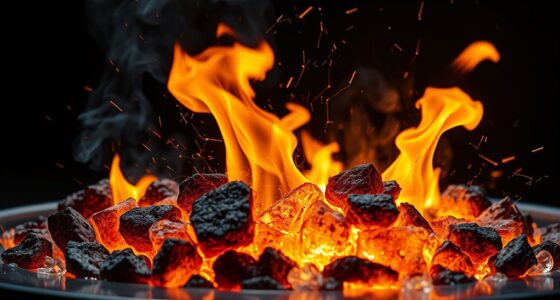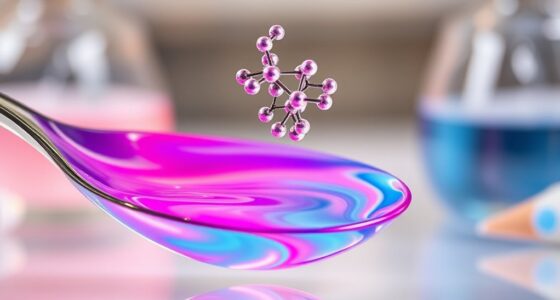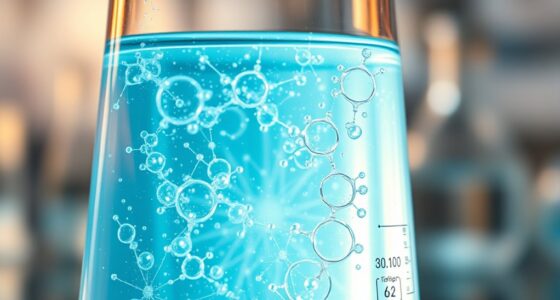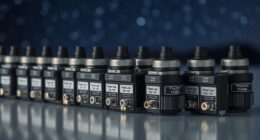To understand whether a chemical reaction will occur spontaneously, you need to take into account both enthalpy and free energy. If the reaction releases heat (negative ΔH) and increases entropy, it’s more likely to be spontaneous, indicated by a negative ΔG. Conversely, an endothermic reaction with decreased entropy may need specific temperature conditions to happen naturally. By studying how enthalpy and free energy interact, you can better predict the reaction’s fate and energy flow; explore more to deepen this knowledge.
Key Takeaways
- Enthalpy change (ΔH) indicates heat release or absorption but does not alone determine reaction spontaneity.
- Negative Gibbs free energy (ΔG) predicts a reaction will occur spontaneously under specific conditions.
- Spontaneity depends on both ΔH and entropy change (ΔS), with temperature influencing their balance via ΔG = ΔH – TΔS.
- Endothermic reactions can be spontaneous if they result in significant entropy increases at higher temperatures.
- Understanding both enthalpy and free energy helps chemists predict, control, and optimize chemical reaction outcomes.

Have you ever wondered how chemists determine whether a reaction will occur spontaneously? It all comes down to understanding two key concepts: enthalpy change and Gibbs free energy. When a reaction takes place, energy is either absorbed or released, which is described by the enthalpy change.
If the enthalpy change is negative, it means the reaction releases heat and is considered exothermic. Conversely, a positive enthalpy change indicates an endothermic process, where heat is absorbed from the surroundings. But enthalpy alone doesn’t tell the full story. To predict if a reaction will happen spontaneously, you need to consider Gibbs free energy, which combines enthalpy, temperature, and entropy.
Gibbs free energy is a measure of the maximum useful work that a reaction can perform at constant temperature and pressure. When the Gibbs free energy change (ΔG) is negative, the reaction proceeds spontaneously, moving toward equilibrium. If ΔG is positive, the reaction is non-spontaneous, meaning it won’t occur without external energy input. When ΔG equals zero, the system is at equilibrium, and no net change occurs.
You can think of Gibbs free energy as a way to gauge the overall “favorability” of a reaction, taking into account both the energy released or absorbed and the disorder or randomness introduced. Furthermore, the relationship between enthalpy change and Gibbs free energy is vital. A reaction with a negative ΔH (exothermic) can still be non-spontaneous if the entropy change isn’t favorable, especially at low temperatures. Conversely, even an endothermic reaction can become spontaneous if it leads to a significant increase in entropy, especially at higher temperatures.
This interplay is described mathematically by the Gibbs free energy equation: ΔG = ΔH – TΔS, where T is the temperature and ΔS is the entropy change. This equation shows that temperature can tip the scales, making a reaction spontaneous or not, depending on the balance of enthalpy and entropy.
Understanding how entropy influences spontaneity is crucial for predicting and controlling chemical reactions effectively. In essence, understanding whether a reaction will occur spontaneously involves evaluating both the enthalpy change and the Gibbs free energy. These factors help chemists predict reaction behavior, design new processes, and control chemical reactions more effectively.
Frequently Asked Questions
How Does Temperature Influence Enthalpy and Free Energy?
Temperature effects play a significant role in chemical processes. As temperature rises, enthalpy fluctuations increase, making reactions more likely to occur if they absorb heat.
Higher temperatures generally decrease free energy, pushing reactions toward spontaneity, especially for endothermic reactions.
You’ll notice that temperature influences both the energy landscape and reaction rates, helping you predict whether a reaction will proceed or not based on how heat impacts the system’s enthalpy and free energy.
Can Reactions With Positive Enthalpy Still Be Spontaneous?
You might wonder if reactions with positive reaction enthalpy can be spontaneous. It’s possible because spontaneity depends on the overall free energy change, not just reaction enthalpy.
According to spontaneity criteria, a reaction can be spontaneous if the entropy increase offsets the positive enthalpy. So, even with positive reaction enthalpy, a reaction can still occur spontaneously if the conditions favor a decrease in free energy.
What Role Do Catalysts Play in Free Energy Changes?
Oh, catalysts, those sneaky little agents that pretend to be helpful! They work by lowering the activation energy, enabling reactions to happen faster without changing free energy.
Their mechanism introduces an alternative pathway, making it easier for molecules to react. So, while they don’t alter the overall free energy change, they accelerate the process, showing off their impressive ability to make things happen—faster, but not forever.
How Is Entropy Related to Free Energy in Reactions?
You might wonder how entropy change relates to Gibbs free energy in reactions. When entropy increases, it typically makes a reaction more spontaneous, lowering the Gibbs free energy.
Conversely, if entropy decreases, the free energy might rise, making the reaction less likely to happen spontaneously.
Fundamentally, entropy change influences the Gibbs free energy, helping you predict whether a reaction will proceed forward under given conditions.
Are There Real-World Applications of Enthalpy and Free Energy Concepts?
You’ll find enthalpy and free energy concepts play a crucial role in real-world applications. In industrial processes, they help optimize energy use and reaction efficiency, reducing costs and environmental impact.
In biological systems, these concepts explain how organisms perform essential functions like muscle movement and cellular activity. By understanding these principles, you can better design energy-efficient systems and improve processes across various fields.
Conclusion
Understanding enthalpy and free energy helps you predict whether a reaction will occur spontaneously. Did you know that about 60% of all known reactions happen without external energy input? By mastering these concepts, you gain insight into the energetic forces at play, empowering you to anticipate reaction outcomes more accurately. This knowledge not only deepens your grasp of chemistry but also opens doors to innovative applications in energy, materials, and medicine.









